Physical Address
304 North Cardinal St.
Dorchester Center, MA 02124
Abdominal wall disorders are frequently encountered in clinical practice, and may be associated with significant morbidity. Most abdominal wall or groin hernias can be easily diagnosed by inspection and palpation. In these cases, radiologic examinations are useful for preoperative demonstration of the hernia’s contents and associated complications. In many instances, small and reducible hernias are discovered incidentally during gastrointestinal barium studies or multidetector computed tomography (MDCT) of the abdomen performed to investigate unrelated conditions. Diagnostic radiology is the principal means of detecting the internal, diaphragmatic, and other nonpalpable or unsuspected hernias.
MDCT, ultrasound (US), and magnetic resonance imaging (MRI) can show several features of hernias that are critical to diagnosis and management: the precise anatomic site of the hernia sac; the shape of the sac and its connections; the hernia cuff and surrounding wall; and complications such as bowel obstruction or incarceration. Multiplanar reformatting (MPR) offers exquisite detail of the anterior abdominal and pelvic wall.
Abdominal hernias can be classified as three major types ( Box 67.1 ). Internal hernia denotes protrusion of the gut through a peritoneal or mesenteric aperture of the omentum, mesentery, or peritoneal ligament, leading to its encapsulation within another compartment of the otherwise intact abdominal cavity. An external hernia (i.e., abdominal wall hernia) is caused by prolapse of an intestinal loop, omentum, or mesentery through a defect in the wall of the abdomen or pelvis. Diaphragmatic hernias, in which the gut, omentum, or mesentery herniates into the chest, are usually considered a separate category. The nomenclature used for specific hernias indicates the anatomic location of their orifice rather than the nature of the protruding organ.
Paraduodenal
Foramen of Winslow
Pericecal
Intersigmoid
Transmesenteric
Retroanastomotic
Abdominal wall
Umbilical
Ventral
Spigelian
Lumbar
Incisional
Pelvic walls and groin
Inguinal
Femoral
Obturator
Sciatic
Perineal
Esophageal hiatus
Foramen of Bochdalek
Foramen of Morgagni
Acquired defects
Internal hernias ( Fig. 67.1 ) are being encountered with increasing frequency as a result of bariatric surgery and liver transplantation, and account for up to 4.1% of acute small bowel obstructions (SBOs). , , , There are certain diagnostic hallmarks shared by the various internal hernias, including: abnormal location of an intestinal segment in susceptible regions; encapsulation and crowding together of several small bowel loops within the confines of the peritoneal cavity; stasis of contrast material in the lumen and dilation of more proximal bowel; and apparent fixation of the herniated loops, preventing their separation or dislodgment during fluoroscopic manipulations or by changing the position of the patient. ,
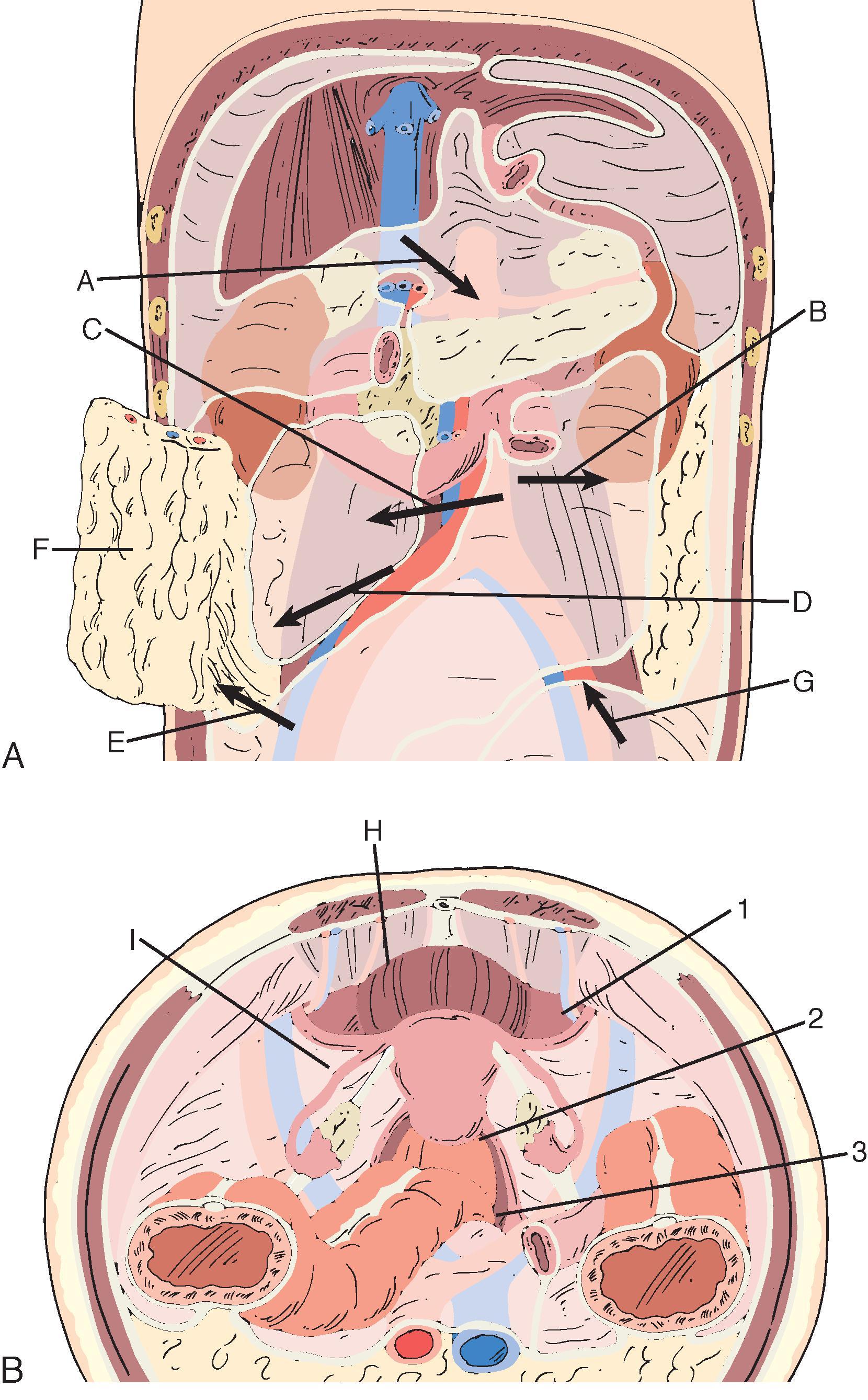
Preoperative radiologic diagnosis or a high index of suspicion for an internal hernia is important because at laparotomy, spontaneous reduction or inadvertent traction of the herniated loops may cause it to be overlooked. The usual abdominal exploration is inadequate for evaluating all peritoneal fossae and mesenteric defects that could serve as potential sites of herniations. ,
Approximately 75% of paraduodenal hernias occur on the left at the paraduodenal fossa of Landzert. This peritoneal pocket is located just lateral to the ascending, or fourth, segment of the duodenum, beneath a peritoneal fold elevated by the inferior mesenteric vein (IMV) and ascending left colic artery. Small bowel loops enter the sac from behind, where the duodenum emerges from its fixed retroperitoneal position. They protrude farther posteriorly and to the left, essentially herniating into the descending mesocolon and distal portion of the transverse mesocolon (TM). ,
Twenty-five percent of paraduodenal hernias develop on the right side of the abdomen and typically involve the mesentericoparietal fossa of Waldeyer. Its orifice is located immediately behind the superior mesenteric artery (SMA) and inferior to the transverse segment of the duodenum; however, the peritoneal pocket itself extends to the right and downward, directly in front of the posterior parietal peritoneum. Accordingly, the right paraduodenal hernia can be viewed as small bowel herniation into the ascending mesocolon. , ,
Contrast examinations of the gastrointestinal tract are most likely to provide the correct diagnosis during symptomatic periods. After the hernia is reduced spontaneously, results of barium studies tend to be negative, and the diagnosis is likely to be missed.
The characteristic radiographic and imaging features of left paraduodenal hernias have been described by several investigators. , , , MDCT may show a circumscribed, ovoid mass of multiple jejunal loops occupying the left upper quadrant immediately lateral to the ascending duodenum ( Fig. 67.2 ). On upper gastrointestinal barium examination (UGI), the hernia indents the posterior gastric wall and depresses the distal transverse colon. Fluoroscopy and serial radiographs reveal a separation of encapsulated loops from the remaining small intestine. Dilation of the involved segments and stasis of barium may also be evident. Because the duodenum is retroperitoneal and the herniated proximal jejunal loops enter the fossa of Landzert posteromedially, only one loop of distal small intestine exits through the hernia orifice. The IMV and ascending left colic artery lie in the anteromedial border of the left paraduodenal hernia. , , These findings are best appreciated during laparotomy, but MDCT of the upper abdomen may demonstrate them before operation.
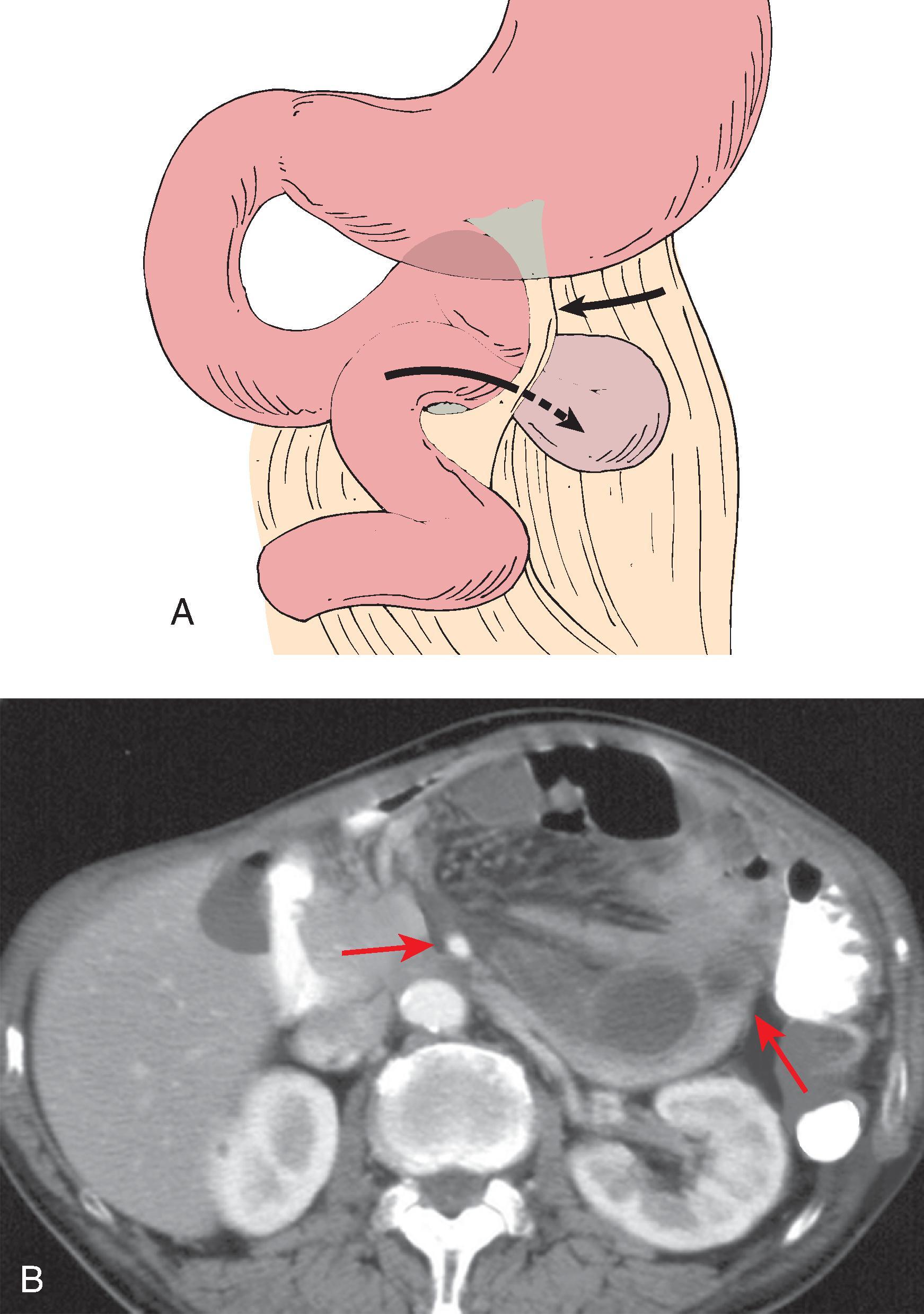
Right paraduodenal hernias are manifested as a similar ovoid grouping of small bowel loops just lateral and inferior to the descending duodenum ( Fig. 67.3 ). They are usually more massive and fixed than those on the left side. Afferent and efferent intestinal loops pass through the hernia orifice, where they are closely apposed and narrowed. , , , , Lateral radiographs are particularly useful for demonstrating the retroperitoneal displacement of the hernia contents. UGI shows that the ascending colon lies lateral to a right paraduodenal hernia, and the cecum retains its normal position.
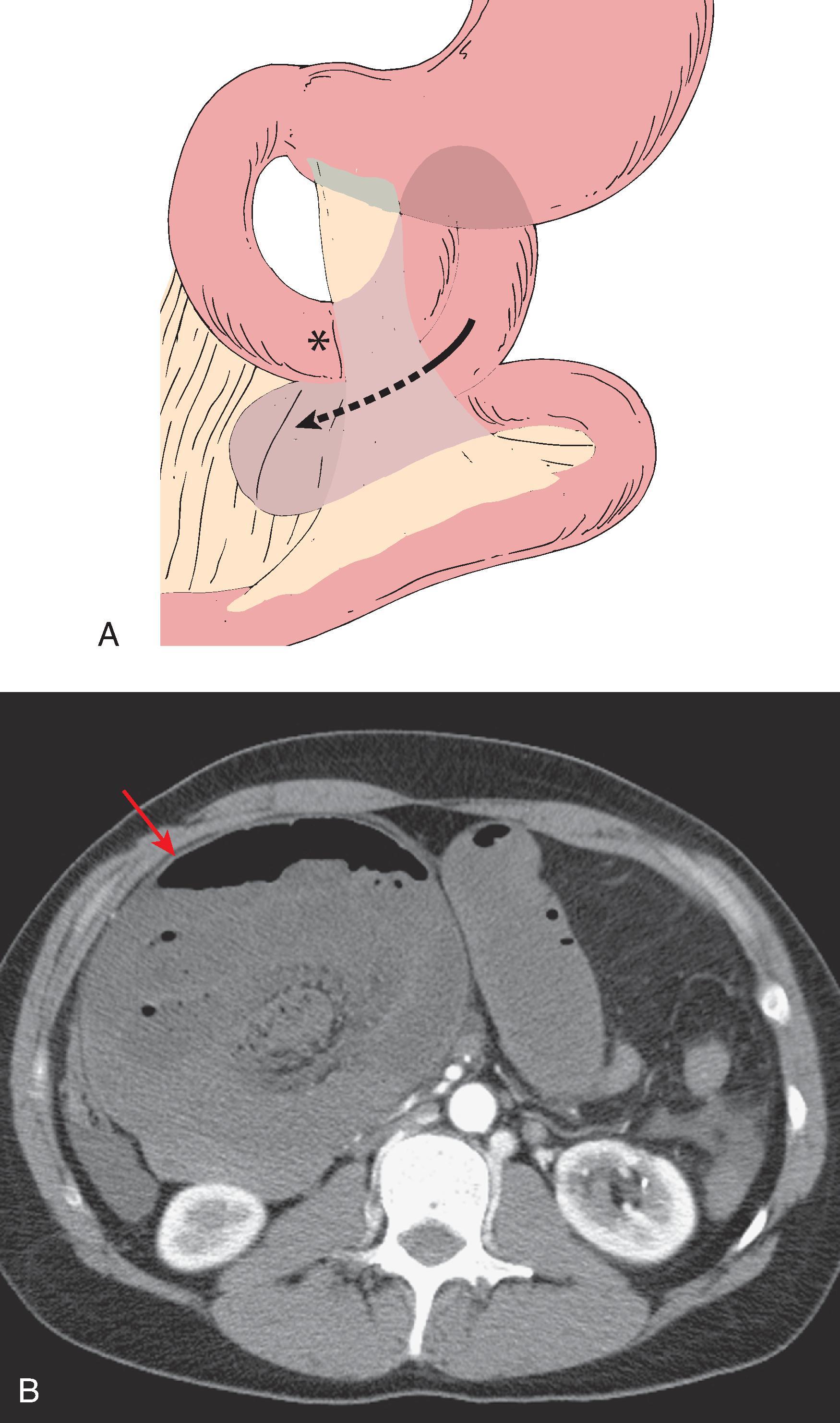
The SMA and its ileocolic branches are situated in the anterior wall of the right paraduodenal hernia sac. The passage of herniated loops behind these vessels causes arteriographically detectable changes. The jejunal arteries, which normally arise from the left side of the SMA, abruptly reverse direction to the right and course behind the parent vessel to supply the herniated loops in the fossa of Waldeyer.
The small epiploic foramen of Winslow can serve as a pathway for protrusion of viscera into the lesser sac. , , The small intestine is the herniated segment in 60% to 70% of cases; however, the right side of the colon, gallbladder, and omentum are also susceptible. Strangulation of a herniated gallbladder and perforation into the lesser sac may occur if it is not diagnosed and treated promptly. Foramen of Winslow hernias are seen in middle-aged patients with an enlarged foramen and excessively mobile intestinal loops (either on a long mesentery or with persistence of the ascending mesocolon). Plain radiographs of the abdomen show gas-containing bowel loops medial and posterior to the stomach, usually in conjunction with markedly dilated proximal small intestine. The right iliac fossa may appear empty if the cecum and ascending colon are the herniated segments. , UGI demonstrates displacement of the stomach to the left and anteriorly. The first and second portions of the duodenum may be compressed and deviated to the left as well. Small bowel follow-through series (SBFT) in patients with SBO can localize the site of obstruction to the right upper quadrant, corresponding to the anatomic location of the foramen of Winslow between the duodenal bulb and the hilum of the liver. If the herniation involves the cecum and ascending colon, barium enema (BE) may reveal a tapered narrowing or obstruction near the hepatic flexure. , MDCT of the abdomen shows an aberrant position of the bowel loops between the liver, stomach, and pancreas ( Fig. 67.4 ). , Bowel loops interposed between the inferior vena cava and portal vein (PV) can be seen on MPR and volume-rendered images.
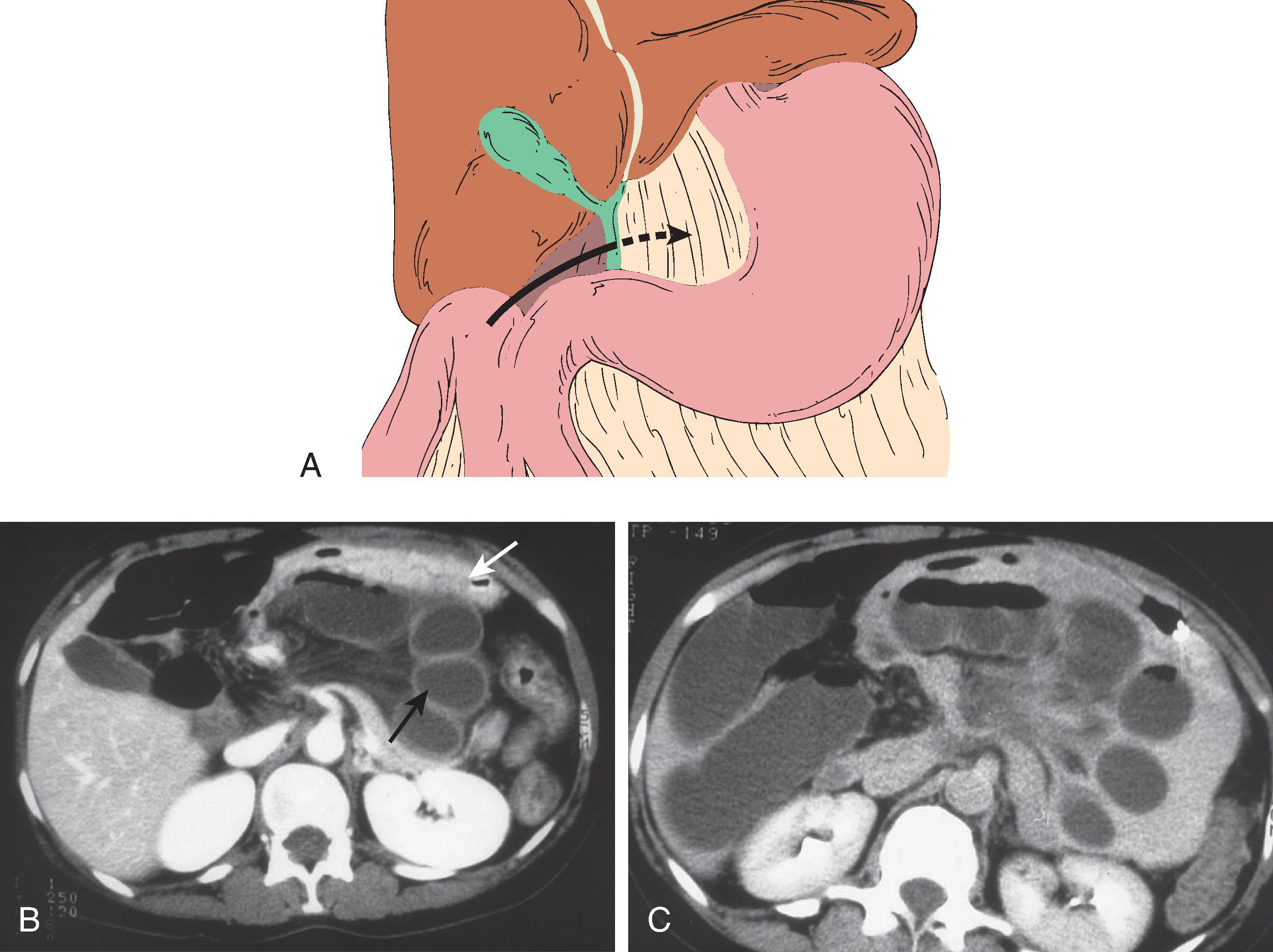
There are two other potential openings to the lesser sac. A defect in the gastrohepatic ligament, which forms the anterior wall of the lesser sac, may occur following partial gastrectomy. Another might be a congenital or acquired defect in the TM or gastrocolic ligament, which constitutes the floor of the lesser sac. Intestinal loops can prolapse through these openings to occupy the lesser sac or reenter the greater peritoneal cavity by the foramen of Winslow. , , ,
Four peritoneal fossae located in the ileocecal region as well as congenital and acquired defects in the mesentery of the cecum or appendix may lead to development of a pericecal hernia. , , In most cases, the herniated ileal segment occupies the right paracolic gutter; the correct diagnosis may be suggested on plain radiographs of the abdomen ( Fig. 67.5 ), provided the unusual relationship of the ileum to the cecum is recognized in association with SBO. Delayed radiographs of SBFT or BE with careful fluoroscopic evaluation and filming in lateral and oblique projections are particularly valuable for demonstrating the fixed position of the herniated ileal loop posterolateral to the cecum. MDCT demonstrates the hernia sac displacing the cecum and ascending colon anteriorly and medially.
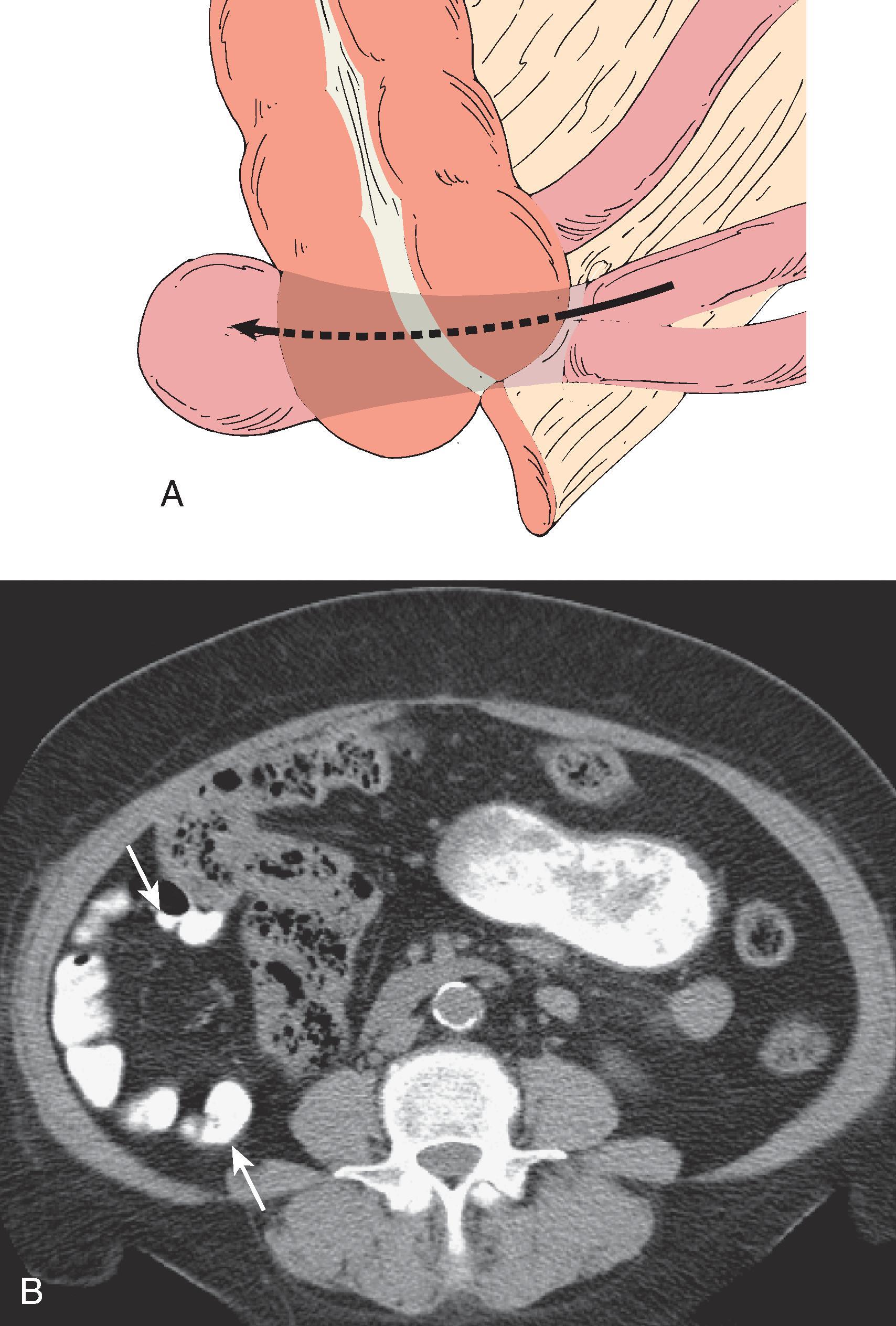
Intersigmoid hernias most commonly involve a peritoneal pouch located between the two loops of the sigmoid colon and its mesentery. , , , On MDCT, the hernia is seen between the sigmoid colon and psoas muscle. Radiologic diagnosis may also be made on BE in which retrograde filling of the small bowel has been achieved, when a portion of jejunum or ileum appear encapsulated between the sigmoid loops ( Fig. 67.6 ). In transmesosigmoid hernias , a defect involving both layers of the sigmoid mesentery allows herniation of the small bowel loops toward the left lower abdomen, posterolateral to the sigmoid colon. The hernia ring is usually a long slit whose fibrous edge is bound by branches of the inferior mesenteric vessels. , In intramesosigmoid hernias , a congenital defect may be present in only one of the constituent leaves of the sigmoid mesentery. The small bowel loops passing through this orifice are incarcerated in a hernia sac, which is formed by separation of medial and lateral leaves of the mesosigmoid. , The sigmoid and superior rectal arteries and veins within the mesosigmoid may be displaced by the hernia sac, a finding which may aid in identifying this subtype on MDCT. However, differentiation of the three types of hernias involving the mesosigmoid is often difficult, and in terms of their ultimate surgical management, is irrelevant.
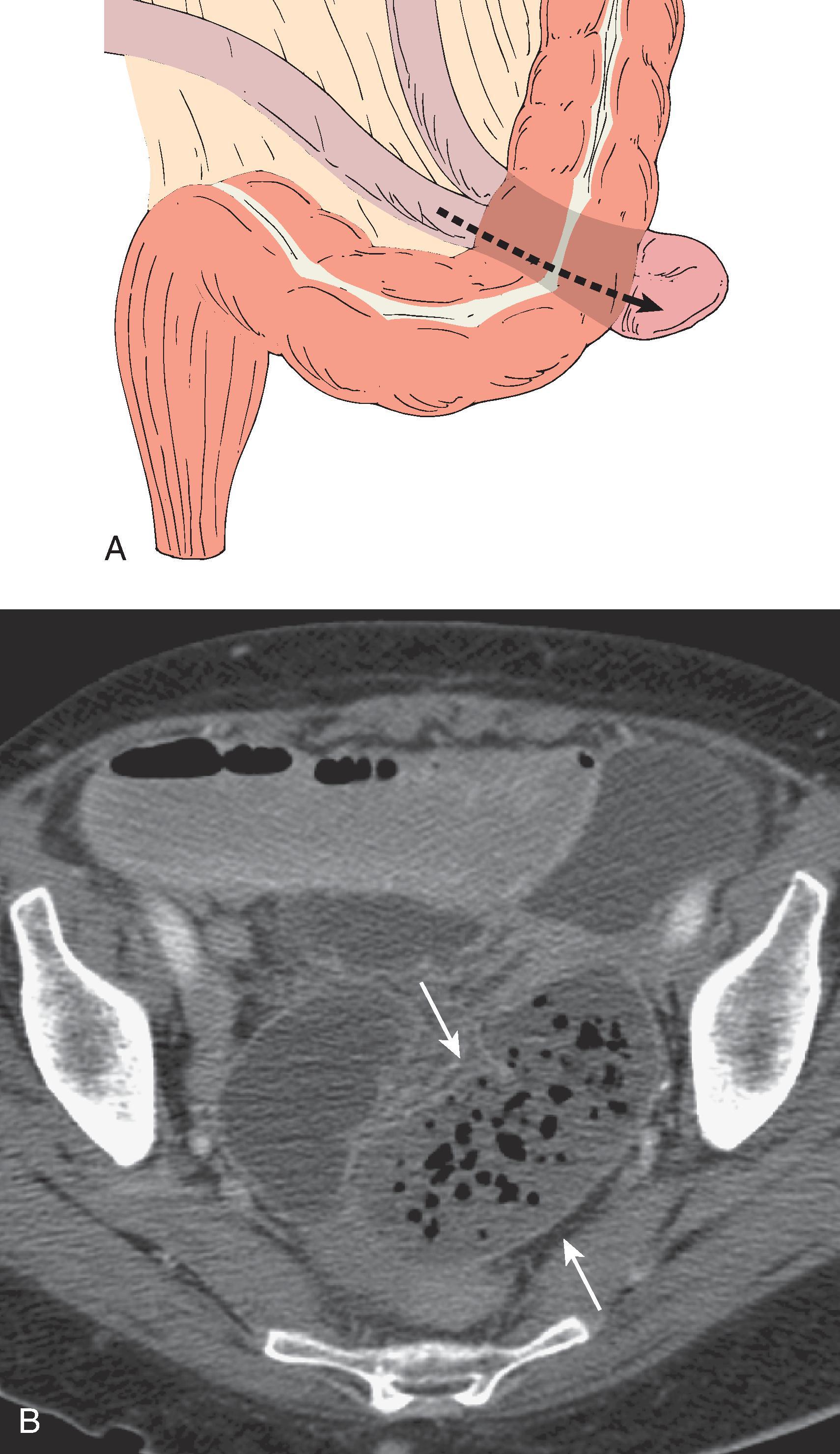
Approximately 5% to 10% of all internal hernias occur through defects in the mesentery of the small bowel. They have no limiting sac, but their functional significance is similar to that of true internal hernias. , Transmesenteric hernias are the most common type of internal herniation in the pediatric age group, and are frequently found in infants with atretic bowel segments. The underlying mesenteric defects are usually located close to the ligament of Treitz or the ileocecal valve. , In adults, most mesenteric defects are probably the result of previous gastrointestinal operations, abdominal trauma, or intraperitoneal inflammation. , ,
In the absence of a limiting hernia sac, a considerable length of small intestine may protrude through the mesenteric aperture. Closed loop SBO may develop ( Fig. 67.7 ), or volvulus may further complicate the process and cause rapid strangulation and intestinal gangrene. SBFT may disclose a constriction around the closely approximated afferent and efferent limbs of the herniated intestine. SMA arteriograms show abrupt angulation and displacement of the visceral branches as they pass through the mesenteric defect to supply the herniated loops.
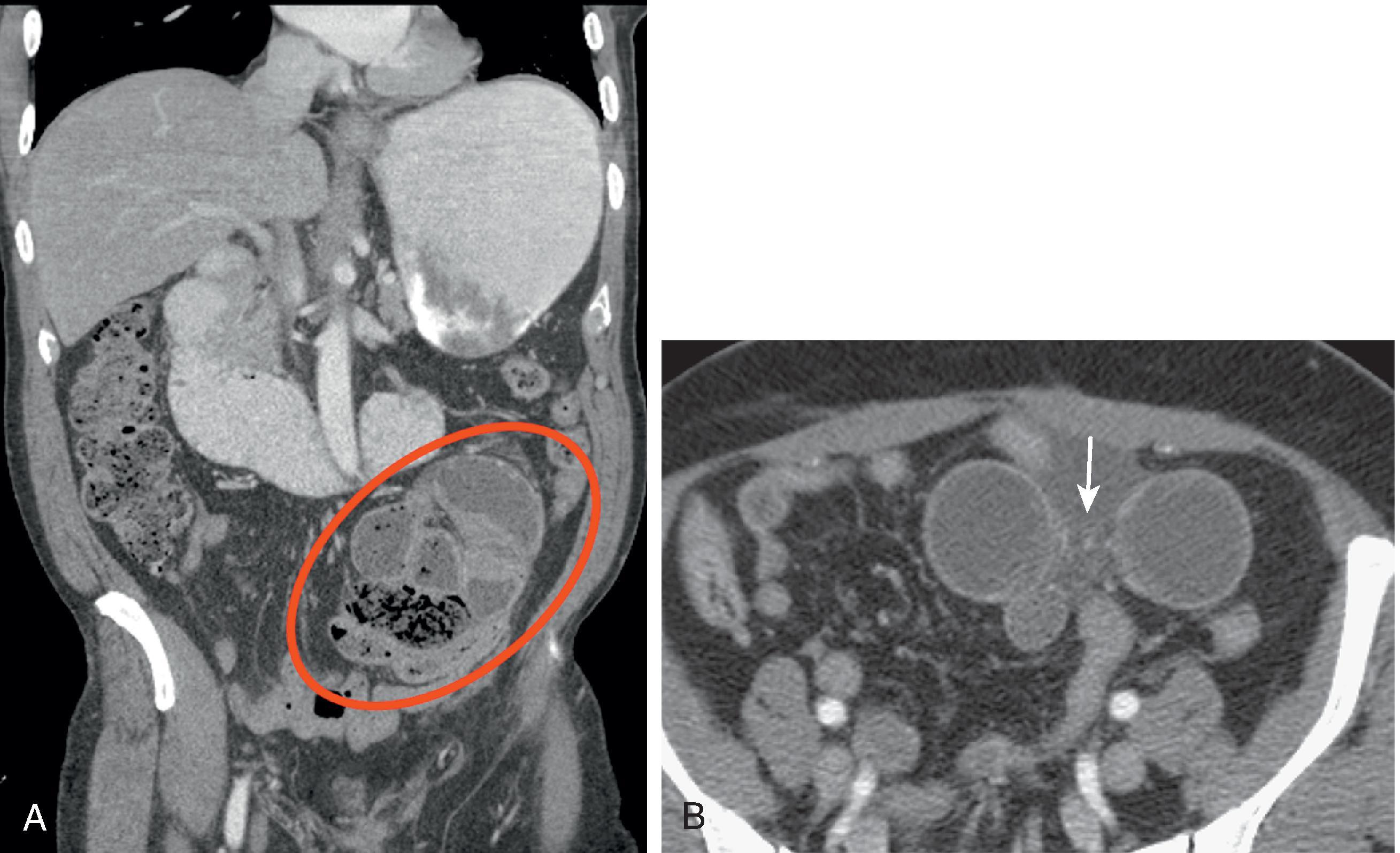
Internal herniation through defects in the greater omentum are very rare ( Fig. 67.8 ). , , The hernia orifice is usually a slitlike opening up to 10 cm long at the periphery of the greater omentum. Most have a congenital origin, but trauma and inflammation may also produce omental perforations or weak areas. The clinical and radiologic findings are almost identical to those of transmesenteric hernias.
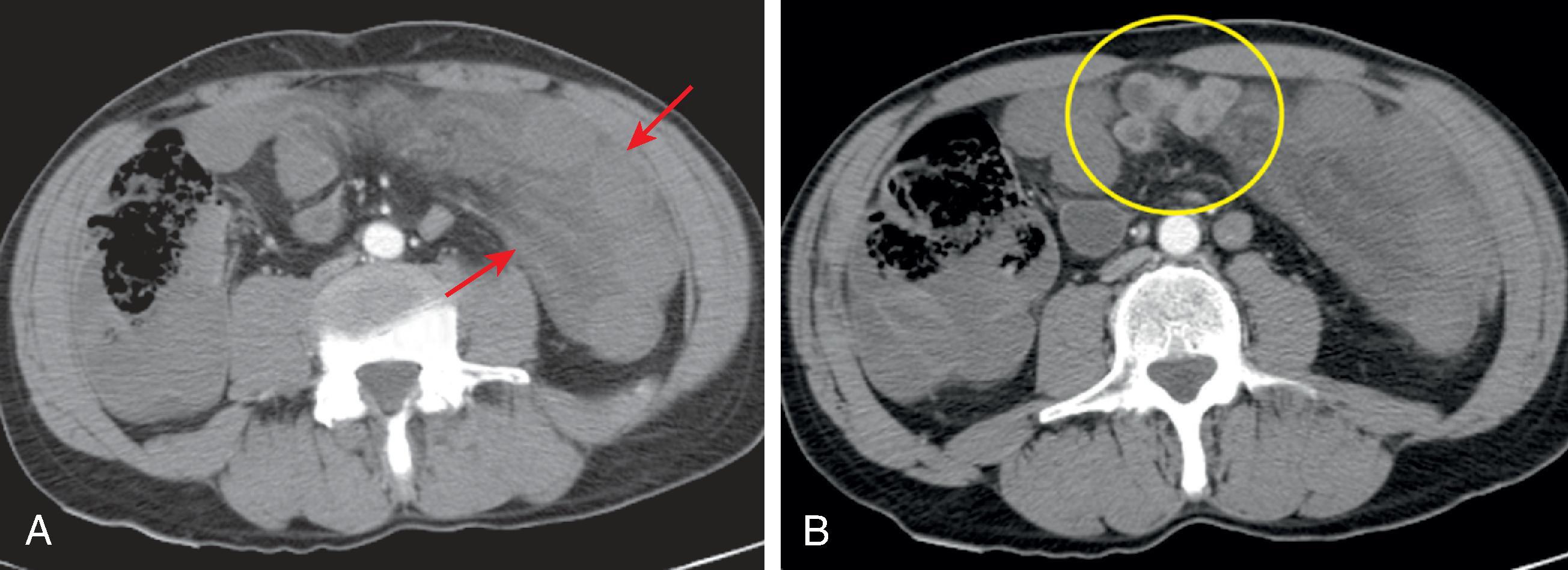
Retroanastomotic hernias are a well-recognized and preventable complication of gastrointestinal surgeries such as partial gastrectomy and gastrojejunostomy.
Become a Clinical Tree membership for Full access and enjoy Unlimited articles
If you are a member. Log in here